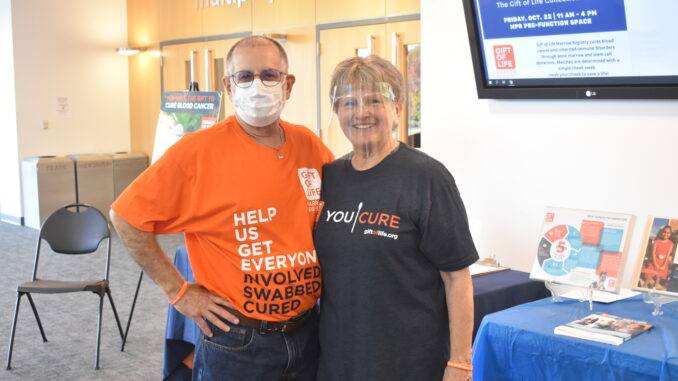
This past Friday, Oct. 22, the Center for Student Engagement hosted a “Be the Match” cheek swabbing event with the Gift of Life Marrow Registry outside of the Multipurpose Room inside the Student Union Building.
The purpose of the event was for students to add their DNA to the Gift of Life Marrow Registry’s database to find matches for patients suffering from over 70 different types of blood related diseases like blood cancer, sickle cell anemia and other inherited immune disorders.
All that students had to do was stop for less than 10 minutes to fill out a form and swab the insides of their cheeks.
From there the swabs are sent back to the Gift of Life headquarters to be processed.
At any point thereafter the Marrow Registry could contact those who registered if a match was made to see if the registered person still wishes to donate.
“By swabbing the cheek, we are able to get cells that we can extract DNA material from,” said Gift of Life volunteer Stacey Lazarus. “From your cheek cells they’re able to extract enough DNA material to see if it matches [a patient’s] DNA material.”
The donations are typically one of two things: blood stem cells or bone marrow.
According to the Gift of Life website, 80% of volunteers donate blood stem cells — 20% donate marrow (primarily for pediatric patients).
Bone marrow transplants are extremely important as they mostly serve to cure children of their ailments.
“Some infants are not able to accept a blood transfer,” said Lazarus. “The other way to get that genetic DNA material into them is through a bone marrow transplant.”
These bone marrow transplants are increasingly important in serving to prevent these diseases in children from becoming too much to deal with.
In most cases they end up saving the life of the child who needed the bone marrow.
After a potential match is found a donor is asked to take a blood test to confirm the match.
If the individual wishes to proceed with the donation they are asked to have a physical examination to see if they are able to donate bone marrow or blood stem cells.
From there, the donor’s blood stem cells or bone marrow will be extracted and then put into the patient’s blood through an IV.
One of the caveats that come along with these transplants and transfers is the fact that the genetic makeup to find a perfect match for a patient has to come from a similar race or ethnic group. Therefore, matches for patients in minority groups are harder to find as there are less people from these groups donating to the registry.
“Today, only 45% of Hispanic/Latinx, 40% of Asian/Pacific Islanders, and 25% of Black and multi-ethnic patients can find a matching donor due to the shortage of volunteers within these groups,” reads the event description on Engage.
“Every 3 minutes someone is diagnosed with a blood cancer or disorder,” according to the New York Blood Center.
These disorders are extremely common to all people, but when there are less donors in certain ethnic or racial groups because they represent a smaller portion of the total population, there is a smaller donor pool for them.
Due to this, they are less likely to be cured of and survive their disease because a matching donor could not be found.
The best thing anyone can do is to look out for events or drives like the one that was hosted Friday and add their information to the registry. The more people registered, the greater the chance for someone to find a perfect match and save a life.
In the last year, two SUNY New Paltz students have been matched with patients and have successfully donated their blood or bone marrow to cure the patients of whatever illness they had.
These students had participated in a similar drive to the one hosted last week and it is proof that anyone is able to save a life.
For those who missed the event on Friday, visit the Gift of Life website, giftoflife.org/swab and have a swab kit sent to your home. You can also keep an eye out for other events like this one.
The Gift of Life website also has a list of all upcoming events, as well. Be the match!

